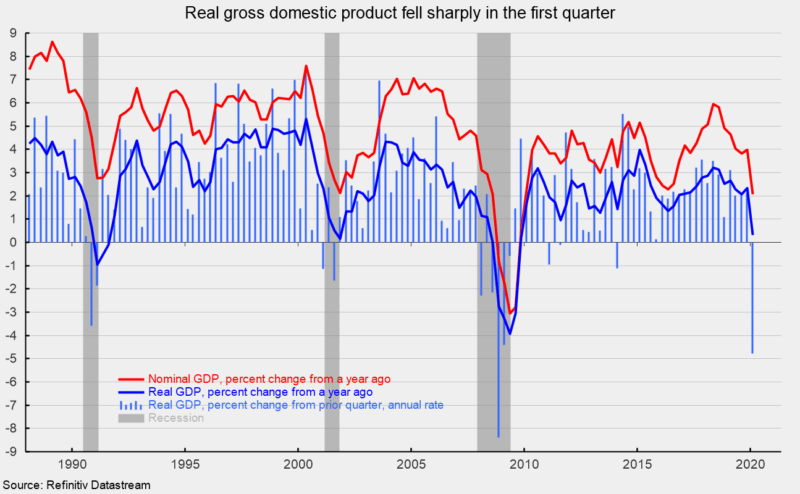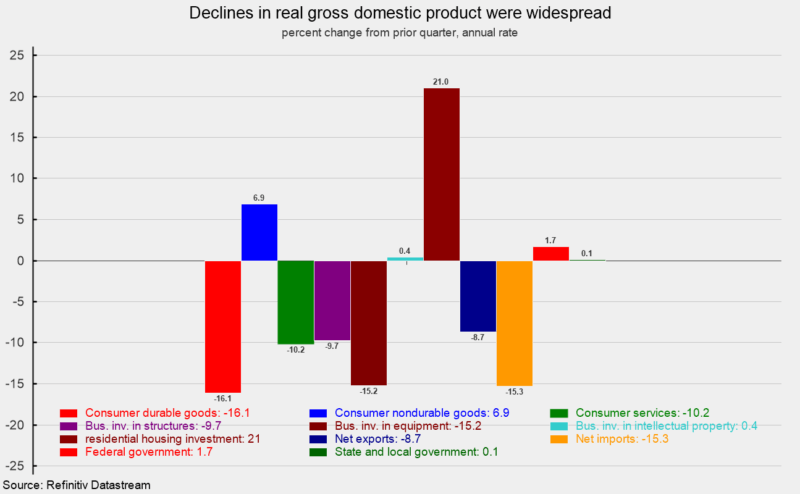U.S. Economy Declines at the Fastest Pace Since 2008
Real gross domestic product fell at a 4.8 percent annualized rate in the first quarter, down sharply from a mediocre 2.1 percent pace in the fourth quarter of 2019, the worst performance since the final quarter of 2008 when the economy plunged 8.4 percent. Over the past four quarters, real gross domestic product is up just 0.3 percent, the slowest pace since the final quarter of 2009 (see first chart). On a nominal basis, gross domestic product fell 3.5 percent in the first quarter, putting the change from a year ago at 2.1 percent (see first chart).
Weakness in the first quarter was expected as the outbreak of COVID-19 and government responses including shelter-in-place orders for individuals and the shutdown of nonessential businesses crushed the labor market and distorted economic activity. With the worst of the impact coming towards the end of the first quarter and extending well into the second quarter, it is a near certainty that second quarter output will decline even more than in the first quarter. Expect the current tsunami of negative economic data to continue for the next few months.
Declines were widespread across the different areas of the economy though there were a few positives. Consumer spending declined sharply in the first quarter, falling at a 7.6 percent pace compared to a 1.8 percent growth rate in the fourth quarter. The decline was the result of sharp drops in spending on durable-goods (down 16.1 percent) and services (-10.2 percent) partially offset by nondurable-goods spending which rose at a 6.9 percent pace in the first quarter versus a 0.6 percent drop in the previous quarter (see second chart). Within the gain in nondurables, food and beverages spending surged 25.1 percent and the catchall other nondurable goods category jumped 12.9 percent while spending on clothing and shoes tumbled 36.0 percent and gasoline and other energy goods spending dropped 5.5 percent. Within the consumer services category, medical care, transportation, recreation, and food services and accommodation all posted sharp double-digit declines.
Business investment fell at an 8.6 percent annualized rate in the first quarter of 2020. That decline was led by a 15.2 percent fall in spending on equipment while spending on structures fell 9.7 percent (see second chart). Intellectual-property investment rose 0.4 percent versus a 2.8 percent gain in the previous quarter. The first quarter rise was all due to an 8.2 percent increase in software while spending on research and development and entertainment, literary and artistic intellectual property posted declines.
Residential investment, or housing, jumped 21.0 percent in the first quarter compared to a 6.5 percent gain in the prior quarter. Housing has increased for three straight quarters though gains are unlikely to continue in the second quarter.
Businesses liquidated inventory in the first quarter, subtracting 0.53 percentage points from first-quarter growth after subtracting 0.98 percentage points in the prior quarter. Inventory liquidation has reduced real gross domestic product for four consecutive quarters.
Exports declined at an 8.7 percent pace, subtracting 1.02 percentage points, while imports declined at a 15.3 percent rate (see second chart). Since imports count as a negative in the calculation of gross domestic product, a drop in imports is a positive for GDP growth. Net trade, as used in the calculation of gross domestic product, added 1.3 percentage points to overall growth.
Government spending rose at a 0.7 percent annualized rate in the first quarter compared to a 2.5 percent gain in the fourth quarter, contributing 0.13 percentage points to growth versus a 0.44-point contribution in the final quarter of last year. Within that total, federal government spending rose 1.7 percent while state and local governments saw a 0.1 percent rise (see second chart).
Real final sales to private domestic purchasers, a key measure of private domestic demand, fell at a weak 6.6 percent annualized rate in the first quarter, versus a 1.4 percent rise in the fourth quarter. Over the past four quarters, real private domestic demand is unchanged.
Consumer price measures were subdued in the first quarter. The personal-consumption price index rose at a 1.3 percent annualized rate, down from a 1.4 percent pace in the fourth quarter. From a year ago, the index is up 1.6 percent, well below the Federal Reserve’s 2 percent target. Excluding the volatile food and energy categories, the core PCE (personal consumption expenditures) index rose at a 1.8 percent pace. From a year ago, the core PCE index is up 1.8 percent and has been at or below 2 percent since 2012.
Overall, the economy likely entered a recession in March, ending the record-long expansion. The first quarter saw a plunge in real gross domestic product along with surging unemployment and a collapse in consumer attitudes. Expect the current tsunami of negative economic data to continue for the next few months.







